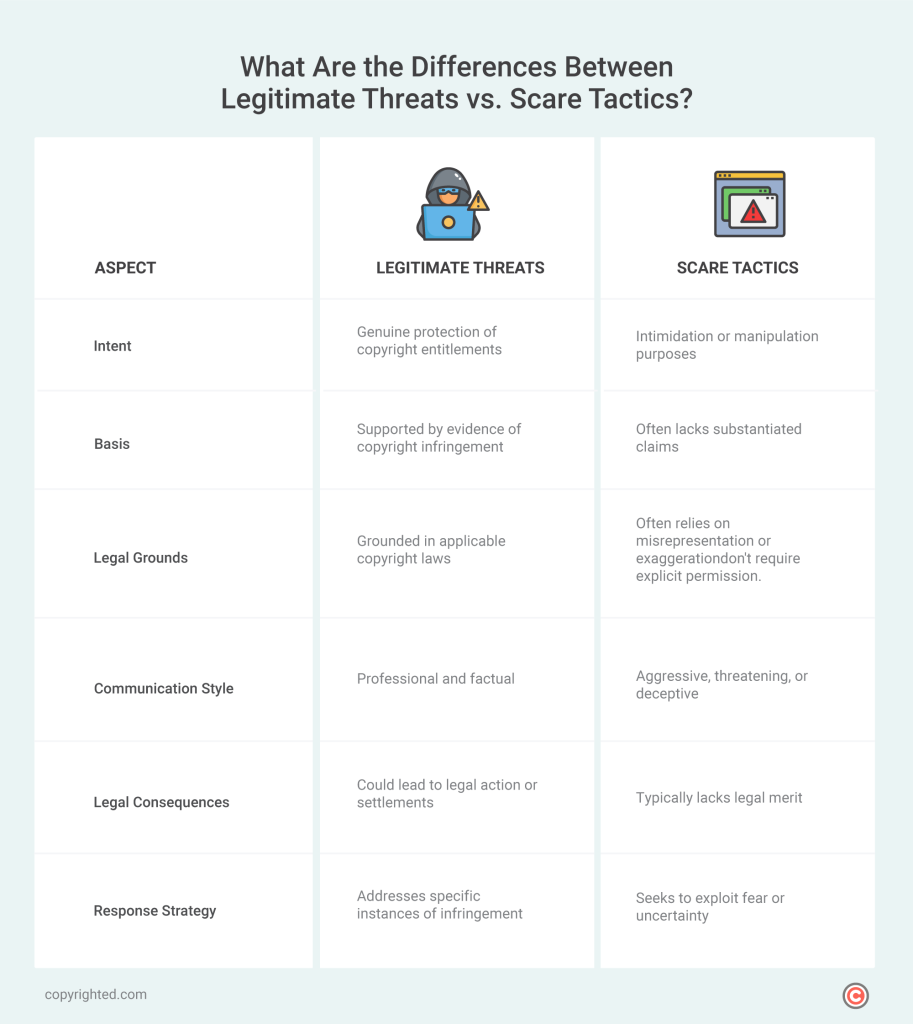Facing a copyright threat can be a daunting experience, particularly if you have confidence in the originality of your work. The instinct to ignore or dismiss such threats, especially when you believe in your innocence, may be strong, but doing so could have serious consequences.
Regardless of the fear or uncertainty surrounding a copyright threat, it’s important to approach the situation with composure and professionalism.
In this article, we’ll delve into the different forms of copyright threats and distinguish them from ingenuine scare tactics. Additionally, we’ll provide practical steps to address these threats, aiming to resolve the situation without making tensions or legal issues worse.
- Copyright infringement threats can take various forms, including cease and desist letters, legal notices, warnings, or litigation initiated by the copyright holder.
- In copyright protection, there’s a fine line between legitimate threats and scare tactics.
- If you receive a copyright infringement threat, you should carefully review the allegations and respond promptly and professionally to address the issue.
Table of Contents
What Are Copyright Infringement Threats?
Copyright infringement threats refer to warnings or legal actions taken against those who are accused of violating copyright laws by using, reproducing, distributing, or modifying copyrighted material without the proper permission of the copyright holder.
Copyright infringement threats typically involve copyright owners asserting their legal rights over copyrighted material. They may issue a warning or take legal action against the copyright infringer.
These threats can take various forms, including cease and desist letters, which demand that the infringing party stop their unauthorized use of the copyrighted material. If the infringing activity continues, the copyright holder may escalate the situation by pursuing litigation, seeking damages, and possibly even requesting injunctive relief to halt further infringement.
Copyright infringement threats are serious matters that can result in legal consequences, including fines, injunctions, and, in some cases, criminal prosecution.
Individuals and businesses must understand copyright laws and ensure proper authorization before using copyrighted material to avoid facing such threats. Additionally, seeking legal advice if you receive a copyright infringement threat is important to understand your rights and potential defenses.
Differences Between Legitimate Threats vs. Scare Tactics?
In copyright protection and enforcement, there’s a fine line between legitimate threats and scare tactics.
Legitimate threats are issued by copyright holders to address actual instances of copyright infringement, aiming to protect their intellectual property rights.
On the other hand, scare tactics involve exaggerated or baseless claims intended to intimidate or manipulate individuals or entities, often for reasons unrelated to genuine copyright protection.
Let’s explore the key differences between legitimate threats and scare tactics through a comparison table:

Steps You Can Take When Facing a Copyright Threat
Whether you’ve received a cease and desist letter, a legal notice, or a warning about potential infringement, it’s important to respond effectively to copyright threats, protect your interests, and handle the situation with confidence.
In this guide, we’ll outline immediate steps to take when facing a copyright threat. By understanding and implementing these steps, you can address the copyright threat in a strategic and proactive manner, minimizing potential legal risks and protecting your rights.
Let’s dive into these actionable strategies:
1. Review the Allegations
Reviewing the allegations of copyright infringement is the first step when faced with a copyright threat. You need to approach this process with thoroughness and attention to detail.
Take the time to comprehend the exact nature of the allegations and carefully evaluate whether the alleged use of copyrighted material indeed constitutes infringement under the copyright law.
Consider the intent behind the copyrighted material’s use and examine the evidence provided by the copyright holder. Seek clarification from the copyright holder or their legal representatives if allegations are unclear.
Consider consulting with a qualified intellectual property attorney to assist you in reviewing the allegations and ensure that your review of the allegations is thorough and accurate.
2. Gather Documentation
Gathering documentation involves collecting any relevant paperwork or evidence that supports your use of the material in question and demonstrates your legal right to use the copyrighted material.
This documentation may include licenses, permissions, contracts, or other agreements that explicitly grant you the right to use the copyrighted material. These documents prove that you have obtained the necessary permissions or licenses to use the material in question and can help support your defense against allegations of copyright infringement.
Additionally, gathering documentation can help you present a clear and comprehensive response to the copyright threat. By providing evidence of your legal right to use the copyrighted material, you can demonstrate that your actions are legitimate and in compliance with copyright law.
Ultimately, gathering documentation is a proactive measure that can strengthen your defense against copyright infringement allegations and help you handle the copyright dispute with confidence and clarity.
3. Seek Legal Advice
Seeking legal advice is important when confronted with a copyright threat. You must consult a qualified intellectual property attorney specializing in copyright law to handle the situation effectively.
An experienced attorney can offer tailored guidance based on your unique circumstances, assessing the copyright threat and recommending the most suitable course of action. This may involve developing a strategic response to the allegations and identifying potential defenses such as fair use.
Additionally, a knowledgeable attorney can help you understand the legal implications of the copyright threat and the potential consequences of various courses of action. They will clarify your legal rights and obligations, helping you make informed decisions about how to proceed.
Consulting with an attorney early in the process can also help mitigate risks and protect your interests. They can offer valuable insights and recommendations to help resolve the copyright dispute efficiently and favorably.
4. Respond Promptly and Professionally
Even if you believe the copyright claim is unfounded, it’s essential to acknowledge the allegations and respond promptly. Ignoring or delaying your response may escalate the situation and increase the risk of legal action.
In your response, provide a clear and concise explanation of your position regarding the alleged copyright infringement. Address each allegation the copyright holder raises, providing any relevant information or evidence to support your case.
Maintain a professional tone throughout your response, avoiding confrontational language or emotional reactions. Demonstrating professionalism in your communication can help potentially facilitate a resolution to the copyright dispute.
By responding promptly and professionally to the copyright threat, you demonstrate your willingness to engage with the copyright holder and address their concerns. This proactive approach can help mitigate the risk of further escalation and position you favorably in any potential legal proceedings.
5. Consider Negotiation or Mediation
Consider negotiation or mediation as viable options for resolving the copyright dispute with the copyright holder amicably instead of costly lawsuits.
This may involve discussing options such as obtaining a license for the copyrighted material and modifying your use of the material to comply with copyright laws.
Negotiation allows both parties to actively participate in finding a mutually acceptable solution to the copyright dispute. By engaging in open and constructive communication, you may be able to reach a resolution that addresses the copyright holder’s concerns while also protecting your interests.
Additionally, mediation can be an effective alternative to litigation for resolving copyright disputes.
A neutral third-party mediator facilitates communication between the parties and assists them in reaching a mutually acceptable agreement. Mediation offers a confidential and non-adversarial environment, allowing both parties to explore creative solutions and potentially preserve their relationship.
Before pursuing negotiation or mediation, carefully consider your objectives and desired outcomes for resolving the copyright dispute. Consult with your attorney to evaluate the feasibility of these options and develop a strategy that aligns with your interests.
6. Cease Infringing Activity if Necessary
If the copyright threat holds merit and it’s determined that you are indeed infringing on the copyright holder’s rights, you need to stop the infringing activity immediately. This means taking prompt steps to remove copyrighted material from all mediums where it is being used without authorization, whether it’s on your website, products, or any other platform.
Ceasing the infringing activity demonstrates your commitment to respecting copyright laws and complying with the copyright holder’s rights. This action also prevents any ongoing harm to the copyright holder’s interests.
Once you’ve removed all of the copyrighted material, communicate this clearly and transparently to the copyright holder. Providing assurance that you have taken corrective action can help mitigate tensions and pave the way for resolution moving forward.
7. Document Communications
Keep detailed records of all communications, including emails, letters, phone calls, and any other correspondence exchanged with the copyright holder or their legal representatives. This includes documenting the date and time of each communication, the individuals involved, and the content discussed.
Additionally, retain copies of any agreements, settlements, or offers made during the course of the copyright dispute. These documents indicate any resolutions reached and can help protect your rights in disputes or legal proceedings.
Doing this establishes a reliable record of the copyright threat and your responses to it. This documentation can be invaluable if legal action is necessary, providing evidence supporting your position and actions.
Ensure that your documentation is organized and easily accessible, allowing you to reference it quickly if needed. Consider storing electronic copies of communications and documents securely to prevent loss or tampering.
8. Monitor Further Developments
Continuously monitor all communication channels for additional correspondence from the copyright holder or their legal representatives.
This includes emails, letters, phone calls, and other communication forms. Pay close attention to the content of these communications, noting any new allegations, demands, or offers made.
In addition to monitoring direct communications, stay informed about any external developments that may impact the copyright dispute. This could include copyright law or regulation changes, relevant court rulings, or developments in similar copyright cases.
This ongoing awareness allows you to adapt your response strategy as needed and take appropriate action to resolve the dispute effectively.
9. Follow Legal Procedures
In the event that the copyright threat advances into a legal dispute, it’s important to adhere to the appropriate legal procedures and deadlines.
Follow any court-mandated procedures for initiating or responding to legal actions related to the copyright dispute. This may include filing legal documents, attending court hearings or mediation sessions, and complying with discovery requests.
Communicate openly and transparently with your attorney throughout the legal proceedings. Provide them with any relevant information or documentation they may need to prepare your case and present your defense effectively.
It’s essential to prioritize compliance with all legal obligations and deadlines to avoid any adverse consequences or sanctions. Failure to adhere to legal procedures can weaken your position and result in unfavorable outcomes in the legal dispute.
Frequently Asked Questions
What forms do copyright infringement threats take?
Copyright infringement threats can take various forms, including cease and desist letters, legal notices, warnings, or litigation initiated by the copyright holder.
What steps should you take if you receive a copyright infringement threat?
If you receive a copyright infringement threat, you should carefully review the allegations, gather relevant documentation, seek legal advice, and respond promptly and professionally to address the issue.
Can you use copyrighted material if you give credit to the original creator?
Giving credit to the original creator does not automatically grant you permission to use copyrighted material. If you want to use someone else’s copyrighted work, you typically need to obtain explicit permission from the copyright holder or determine if your use falls under a legal exception, such as fair use.
How can you protect your content from being infringed upon by others?
You can protect your content by registering your copyrights, using copyright notices, monitoring your content for unauthorized use, and taking appropriate legal action against infringers.
Can you negotiate with the copyright holder to resolve a copyright infringement dispute?
Yes, you can negotiate with the copyright holder to resolve the dispute. This may involve getting permission, settling, or seeking mediation. Consulting a legal expert can help handle negotiations effectively.


